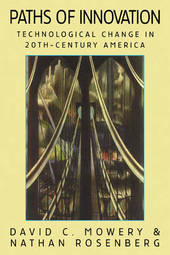
|
Paths of Innovation: Technological Change in 20th-Century America
Paperback / softback
Main Details
| Title |
Paths of Innovation: Technological Change in 20th-Century America
|
| Authors and Contributors |
By (author) David C. Mowery
|
|
By (author) Nathan Rosenberg
|
| Physical Properties |
| Format:Paperback / softback | | Pages:228 | | Dimensions(mm): Height 229,Width 152 |
|
| Category/Genre | Impact of science and technology on society
Technology - general issues |
|---|
| ISBN/Barcode |
9780521646536
|
| Classifications | Dewey:303.4830973 |
|---|
| Audience | | Tertiary Education (US: College) | | Professional & Vocational | | General | |
|---|
| Illustrations |
15 Tables, unspecified; 12 Line drawings, unspecified
|
|
Publishing Details |
| Publisher |
Cambridge University Press
|
| Imprint |
Cambridge University Press
|
| Publication Date |
28 October 1999 |
| Publication Country |
United Kingdom
|
Description
In 1903 the Wright brothers' airplane travelled a couple of hundred yards. Today fleets of streamlined jets transport millions of people each day to cities worldwide. Between discovery and application, between invention and widespread use, there is a world of innovation, of tinkering, improvement and adaptation. This is the world David Mowery and Nathan Rosenberg map out in Paths of Innovation, a tour of the intersecting routes of technological change. Throughout their book, Mowery and Rosenberg demonstrate that the simultaneous emergence of new engineering and applied science disciplines in the universities, in tandem with growth in the Research and Development industry and scientific research, has been a primary factor in the rapid rate of technological change. Innovation and incentives to develop new, viable processes have led to the creation of new economic resources - which will determine the future of technological innovation and economic growth.
Reviews"Rosenberg and Mowery are among the nation's premier historians of technical change. They relate the sagas of four technologies--the internal combustion engine, the chemical industry, electric power, and the electronics revolution that followed the invention of the transistor in 1947--and look for patterns that repeat among the details that do not." Boston Globe
|